7 Problems in Adapting Harry Potter and the Deathly Hallows
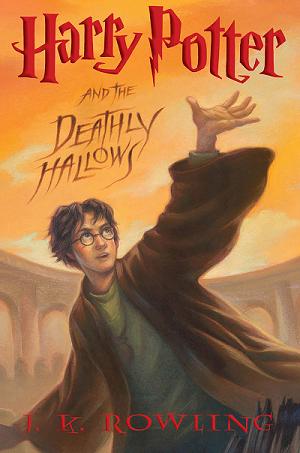 | | Harry Potter and the Deathly Hallows |
Now that the sixth Harry Potter film has been released, it is natural to wonder how the producers of the Potter films are going to adapt the final book in the series, Harry Potter and the Deathly Hallows. Unfortunately, as a natural and unavoidable side effect of adapting the previous six books, there are several seemingly minor characters and plot points from those books that are not found in the movies. Anybody who has read the last book knows that many of these trimmed story devices become enormously important in the final Potter tale.
These are the seven most critical plot points I have identified from a recent rereading of the seventh novel that are potential stumbling blocks for the final two films (if you don't know yet, the book is being split into two full-length movies to be released roughly eight months apart). The filmmakers are likely to have already agreed on how to address these seven issues--as the first film is already filming and Steve Kloves, the screenwriter, has already started working on the second--but that shouldn't stop us from speculating.
A little bit of research can uncover some nuggets of information about the production, so be warned that there will be one or two minor spoilers ahead for those that have read the final book. If you haven't read it, then pretty much everything that follows this paragraph will be a spoiler.
The Magic Mirrors
 | | "What was sundered and undone shall be whole - the two made one" ...sorry, wrong shard |
In the books: In Harry Potter and the Order of the Phoenix, Sirius Black gives Harry one of a pair of two-way mirrors that can be used for magical communication. Harry then forgets about this mirror until the end of the novel, at which point Sirius has died and Harry's mirror seems worthless. Harry smashes the mirror in frustration, and nothing more is said about it until the final novel (although keen readers can find the moment where Aberforth Dumbledore purchases the missing half from Mundugus Fletcher in Half-Blood Prince). Then, in Deathly Hallows, the mirrors become tremendously important. Harry finds a shard of his at the bottom of his school trunk and carries it with him throughout the rest of his adventure. It turns out that the other half now rests in the possession of Aberforth Dumbledore, who uses it to keep an eye (literally) on Harry and send help his way at a critical moment.
In the movies: Needless to say, the mirrors never appear in the film versions of Order of the Phoenix or Half-Blood Prince. It would be disorienting for an audience not familiar with the books for the mirror to suddenly appear at the start of Deathly Hallows, and any explanation shoe-horned in would feel a bit too much like retconning. Therefore, the only logical way out for the filmmakers is to introduce a different plot device that could serve the same purpose as the mirror (namely, allowing Aberforth to keep an eye on Harry and allowing Harry to ask him for help when trapped in Malfoy Manor). Unfortunately, there is a picture online of Harry holding his mirror shard in the seventh film, so the filmmakers must have chosen the less logical, more direct choice of introducing the shard as if the mirrors had been introduced in a previous story (kind of like how Peter Pettigrew is addressed as Wormtail after Prisoner of Azkaban, even though it is never explained in that movie that Pettigrew and Wormtail are one in the same).
Bill Weasley
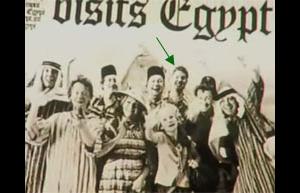 | | Okay, so he appeared in Prisoner of Azkaban, but his role was very tiny |
In the books: Bill Weasley is a relatively important character in the Potterverse. In Goblet of Fire, Bill meets Harry for the first time at the Quidditch World Cup and then later assists him in the Triwizard Tournament. There he meets Fleur--whom he would marry in Deathly Hallows--and acts as a messenger for Dumbledore following the return of Voldemort. He appears in Order of the Phoenix as a member sending out feelers to the goblin community. In Half-Blood Prince, he is among the group defending Hogwarts from the Death Eater attack, and he is severely injured by werewolf Fenrir Greyback. Then, in Deathly Hallows, Bill marries Fleur (though their wedding is interrupted by Death Eaters) and later offers sanctuary to Harry and his friends. He gives Harry advice in dealing with goblins before Harry leaves again with the goblin Griphook. He then appears in the final battle at Hogwarts.
In the movies: Surprisingly, Bill Weasley has yet to appear in a Harry Potter film, despite his important role in the novel for Goblet of Fire. However, it would be incredibly difficult to adapt Deathly Hallows without him, as his wedding to Fleur is a major scene in which several important things take place. Bill and Fleur's home is also a critical locale that would be hard to replace, especially since The Burrow is destroyed in the film version of Half-Blood Prince (a potential problem not addressed in this list). Therefore, Bill Weasley almost must be a character in the final two films, but fortunately, introducing his character so late in the game wouldn't stink of retconning the way the mirrors would. (Spoiler: the character has been cast in the final two films.)
The Horcruxes
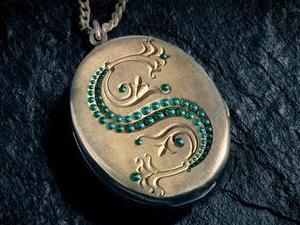 | | This locket has absolutely nothing in common with the one ring carried by Frodo and Sam |
In the books: In Order of the Phoenix, Harry and his friends hole up at the Black family home in Grimmauld Place. There, while cleaning house, they find a locket none of them can open. In Half-Blood Prince, while in the Room of Requirement, Harry stumbles across an ornate crown that later turns out to be the lost diadem of Rowena Ravenclaw. In the same book, Dumbledore takes Harry into several key memories involving Voldemort's past. When it is revealed that Voldemort has created horcruxes, Dumbledore and Harry reason that Voldemort is trying to get his hands on relics of the four founders of Hogwarts in order to turn at least one from each into a horcrux. In Deathly Hallows, Harry uses this inference to find Hufflepuff's cup and Ravenclaw's lost diadem, both of which turn out to be horcruxes. Also in Deathly Hallows, the locket from Order of the Phoenix turns out to be an incredibly important item, as it once belonged to Salazar Slytherin and is also one of Voldemort's horcruxes.
In the movies: The film version of Order of the Phoenix completely omits the cleaning of Grimmauld Place, and thus fails to introduce Slytherin's locket. Then, in Half-Blood Prince, the filmmakers omitted several of the trips Dumbledore and Harry take in the pensieve, trips that would have introduced the audience to the cup, the locket, and the possibility that Voldemort returned to Hogwarts to find other artifacts to turn into horcruxes. These omissions present possibly the biggest obstacle to adapting Deathly Hallows. There would need to be a device in the new films that would allow Harry to realize that Voldemort tried to collect an important artifact from each of Hogwarts' founders to use as horcruxes. He would have to see the cup--so that he can identify it in the Gringotts vault--and the diadem, so that he can identify it in the Room of Requirement (since the diadem was omitted in the film version of Half-Blood Prince). As for the locket, I don't see how they can possibly cover up the omission.
Mundungus Fletcher
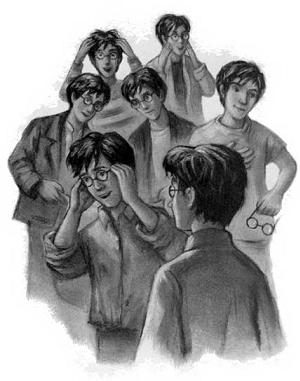 | | This is the only illustration of Mundungus Fletcher |
In the books: Mundungus Fletcher is a questionable inductee in the Order of the Phoenix with a penchant for thievery. In Deathly Hallows, Mundungus is important for two reasons. The first is that the plan to use decoys comes from him (actually, it comes from Snape, who is magically controlling Mundungus) and is the reason the Death Eaters know when Harry is set to leave the Dursley's. The second is that he is a link in the evidence chain that leads Harry and his friends to Slytherin's locket. It turns out that, before Deathly Hallows, Mundungus stole the locket and sold it to Dolores Umbridge.
In the movies: Without Mundungus, who has yet to appear in any of the films, there is no direct way to track ownership of the locket from Regulus Black to Dolores Umbridge. It wouldn't be as difficult to gloss over his absence in the flight from the Dursley's, though there would have to be an explanation for how the Death Eaters know the date of the plan. Fortunately, this is a moot point; Mundungus Fletcher has been cast in the first part of Deathly Hallows. There will still have to be at least a reference to Mundungus' kleptmaniac nature, but it is starting to trouble me that many of the simplest solutions to these problems so far involve adding expository explanations to cover up previous omissions.
Dumbledore's Tomb
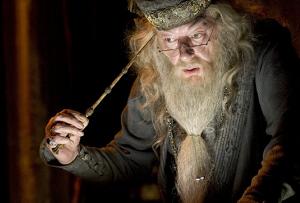 | | Who knew how important that wand would be? |
In the books: At the end of Half-Blood Prince, after Dumbledore dies, he is buried--with his wand--in a white tomb on the grounds of Hogwarts. In Deathly Hallows, it is revealed that at the time of his death, Dumbledore was in the possession of a special wand called the Elder Wand. The Elder Wand, a wand that cannot be beaten by any other wand, is one of the Deathly Hallows (which you can guess makes it pretty important to the story), and Voldemort gets his hands on it by robbing Dumbledore's tomb.
In the movies: The end of Half-Blood Prince does not include Dumbledore's funeral or show his tomb. This might not be a difficult omission to correct, because it would be possible to open Deathly Hallows with the same funeral. If not, it also wouldn't feel like retconning to introduce Dumbledore's tomb or show Voldemort raiding it, since an audience unfamiliar with the books would have to assume that Dumbledore was buried somewhere. Indeed, the fact that Dumbledore is buried at Hogwarts isn't very important.
Dobby
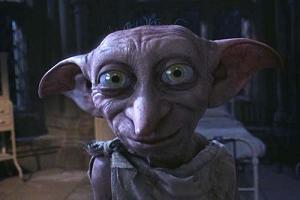 | | Dobby: completely ignored for four movies |
In the books: Dobby is a house-elf who appears in every Potter novel except the first one. He serves important roles in each of the stories, including telling Harry about gillyweed (which helps him in the Triwizard Tournament in Goblet of Fire) and the Room of Requirement (which is crucial in Order of the Phoenix, Half-Blood Prince, and Deathly Hallows). In Deathly Hallows, Dobby is sent by Aberforth Dumbledore to help Harry out at Malfoy Manor. Dobby can use elven magic, which skirts around the mansion's magical protections, and is critical in rescuing Ollivander, Luna, Harry, Ron, and Hermione. Indeed, his life is ultimately sacrificed in the rescue, and his death is one of the most emotional scenes of the entire series. That death is the major turning point in Harry's inner struggle, so it would be difficult to understate its importance for the plot.
In the movies: Dobby does appear in Chamber of Secrets, but is conspicuously absent from every movie that follows. His important actions are either relegated to Neville Longbottom or omitted altogether, and that presents a number of problems for Deathly Hallows. First of all, only an elf can do what Dobby does in the story (and Neville's busy at Hogwarts anyway), and the fact that audiences haven't been exposed to his character for more than one movie means that his death will not have the same punch it does in the novel (especially since his role in the novel is remarkably short). Luckily, Dobby has been confirmed to return in Deathly Hallows, but it's probably too little too late.
The Room of Requirement
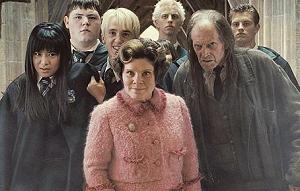 | | This is a narrative short-cut that poses unforeseen problems |
In the books: The Room of Requirement is a secret chamber in Hogwarts that is able to morph itself into whatever an individual needs at the time. It serves as the base of operations for Dumbledore's Army, a student resistence movement in Order of the Phoenix and Deathly Hallows. It is also the place where students have spent years hiding various items (including the vanishing cabinet Draco uses to start the invasion of Hogwarts in Half-Blood Prince as well as Ravenclaw's lost diadem, which Voldemort once hid there while applying for a job at Hogwarts). In Deathly Hallows, the Room of Requirement is not only important as the home of the diadem or the headquarters for Dumbledore's Army, but it is also the place where Harry and his friends infiltrate the building from a passageway at the Hog's Head.
In the movies: The Room of Requirement does appear in Order of the Phoenix and Half-Blood Prince, but unfortunately, in Order of the Phoenix, Dolores Umbridge, Filch, and the Inquisitorial Squad (mostly consisting of Slytherins) find out about the room and find a way to break into it by blowing up the wall. Surely, in Deathly Hallows, Filch and the Slytherins would do the same thing when the students start using the room for a base of resistence. This is a subtle but important problem, and needs to be addressed. There is a scene in the novel for Deathly Hallows in which Neville is talking about how he has gotten more and more specific in making requests for the room. All you would need to do to close the plot hole would be to add an extra line of dialogue to the movie in which Neville explains that he has made special provisions against infiltration by explosion. Unfortunately, even though this is the easiest problem to fix, I fear it is the one most likely to be overlooked by the filmmakers.
-e. magill 08/10/2009
|
|